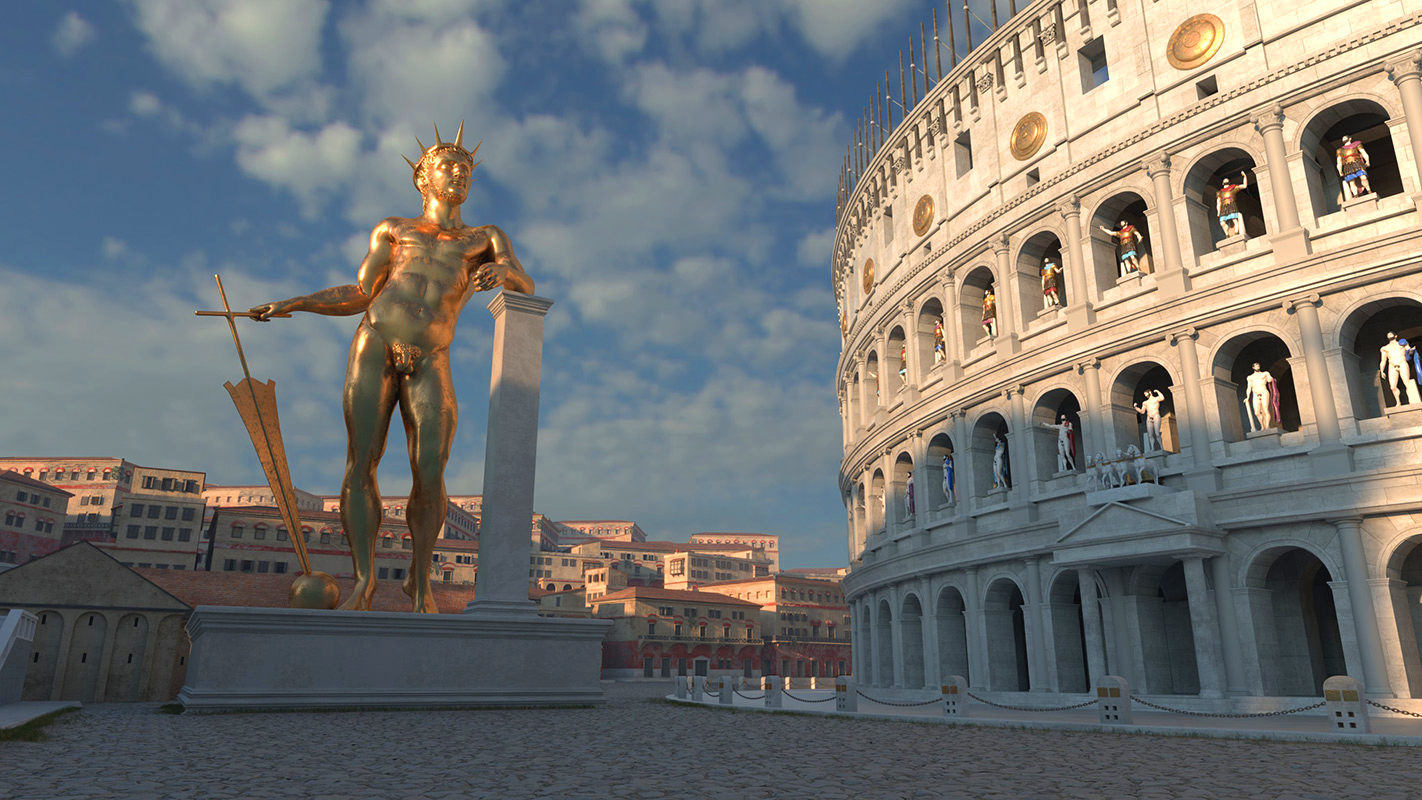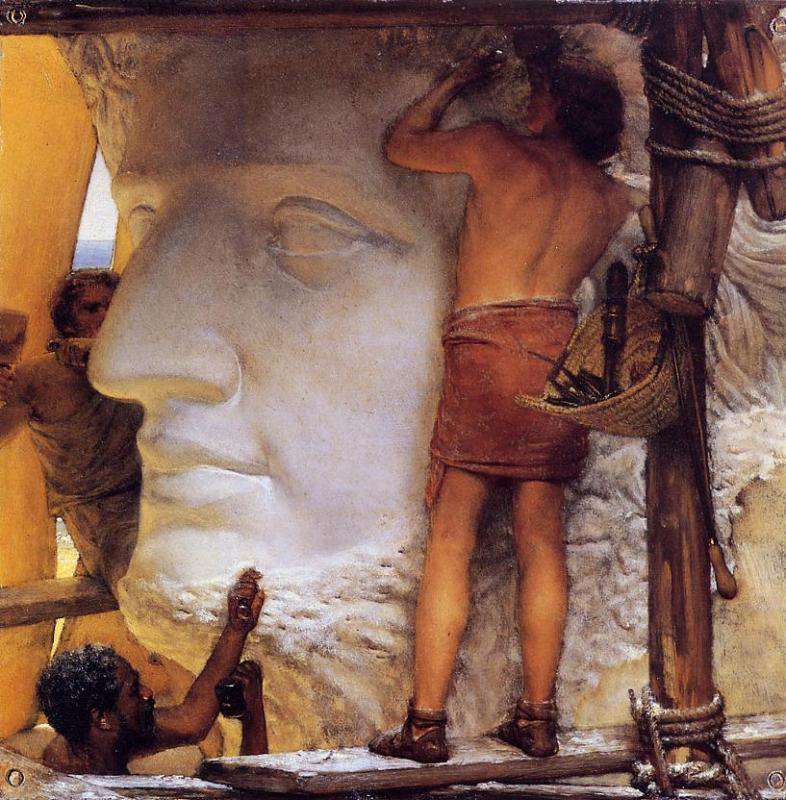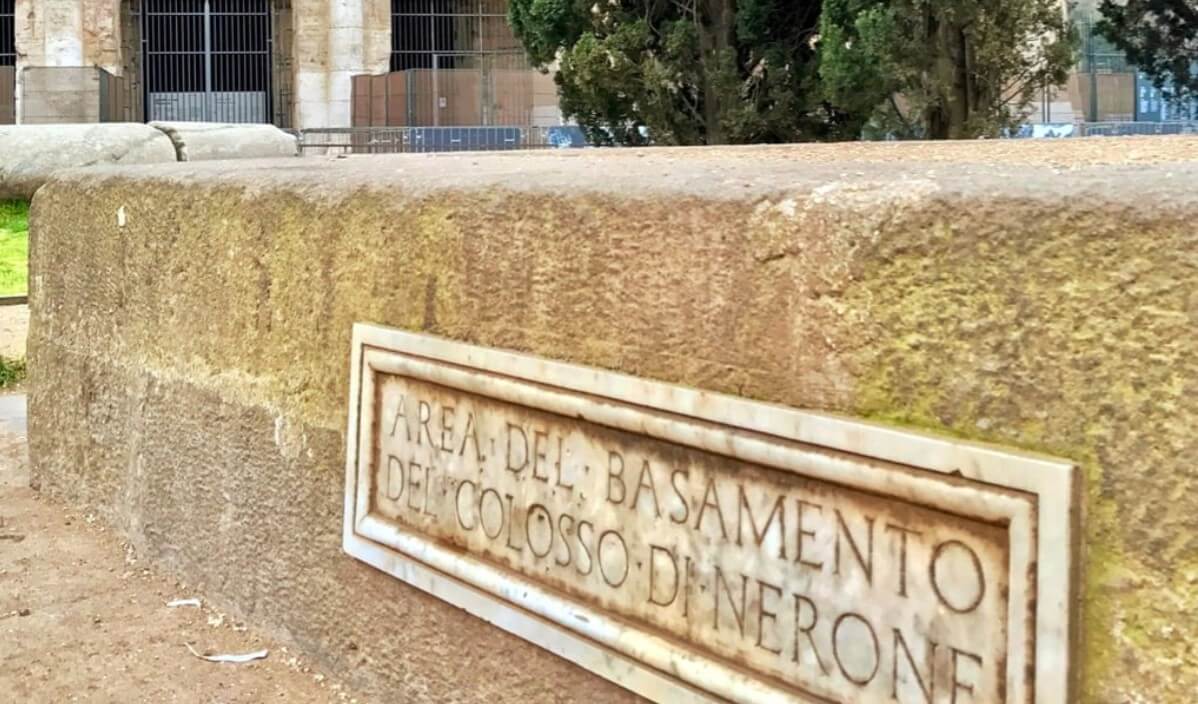
The Colossus of Nero – Megalomania or Fake News?
The Colosseum is the MOST visited attraction in Rome, originally called the Flavian Amphitheatre; yet Kolosseum (COLOSSEUM TAB) is a nickname from the middle ages recalling not the size of the gladiatorial arena but of an entirely different monument – a gigantic bronze statue so-called The Colossus of Nero. Ancient writers tell of an enormous bronze statue commissioned by the narcissistic and crazed young emperor Nero for the entrance of his party palace the ‘Domus Aurea’(AROME/DAUREATAB (, built after the ‘Great Fire’ of 64 AD. Tradition has it that the statue was of the emperor Nero posing as the sun god Sol, an attempt by Nero to grasp divine status while still living. There are many stories about the statue, its size, the face and what happened to it. Several emperors changed the face of the statue, adding their own likeness or removing that of an earlier emperor. Yet despite its association with an apparently crazed and despotic ruler the statue endured for at least three hundred years!
Colossal statues known as Colossi were known in Greece; the Parthenon on the sacred acropolis in Athens had a chryselephantine (ivory and gold) statue of Palas Athena inside the main temple area. It was only a matter of time for the Romans to follow suit. Large statues of the emperor were not new, but a statue eighteen times life-size in a precious material was unheard of and such a large statue of the emperor as a God was sheer madness.
Fake News?
Television, books and tour guides tell the incredibly juicy story of Nero that goes something like this: He set fire to the city of Rome in 64 AD so that he could steal public land in the centre of the city. He built a private pleasure palace on that land complete with an enormous statue of himself. He then blamed it on the Christians and executed them in the circus martyring the famous saints Peter and Paul in the process. But as with all things in history if we dig a little deeper it is a bit more complicated than that. The sources we have are various histories, written at different times after Nero’s death; some more reliable than others. Specifics like dates and concrete facts are missing, the sources do not even agree on the height, the likeness or when it was completed.
Pliny the Elder tells us the artist Zenodorus (otherwise unknown to us), who was famed for his skill at producing colossal statues, was brought from Gaul by Nero to create the statue. When the statue was commissioned and how long it took is not recorded.
How big was the Colossus of Nero?
Our three main sources are Pliny, Suetonius and Cassius Dio, all writing at different times and they do not agree. Pliny tells us he visited Zenodorus’ workshop and so perhaps is the most reliable. “Summoned to Rome by Nero, he made a colossus 106½ feet tall”; the text is corrupted, some claim it reads 119 feet, or it may have been copied wrongly by later writers. Suetonius tells us it was 120-foot-tall and Cassius Dio writing over a hundred years later tells us one hundred feet high. The statue wore a crown with rays (of sun) coming out of it – was this included in the height of the colossus?
Over fifty years later Hadrian placed the statue on a marble covered base next to the Flavian Amphitheatre. So, the colossus was somewhere between 106ft and 120 ft with or without its crown and base. We have the added problem that the length of the Roman Foot is variously measured today.
In 1828, archaeologists unearthed a brick faced, rectangular base measuring 17.60 x 14.75 m, with a height of 2.25 m, originally covered with marble revetments. It was visible until 1933, when it was sheared off and paved over by the Via dei Fori Imperiali.
Nero never saw himself!
We have no idea when work on the Colossus began, was it after the fire when Nero’s plans came to mind? If so, then the earliest can be 64 AD. We imagine that Nero basked in the shadow of a colossal version of himself but that cannot actually have been possible. The timescale required to produce other bronze statues of a similar size was at least nine years, perhaps even eleven if the statue was 120ft high. In which case Nero would never have seen his likeness in bronze because he died only four years after the fire! Cassius Dio says the statue was actually finished and erected under Vespasian.
Was the Colossus of Nero or the sun god Sol?
After his death, Nero’s works were rapidly undone or covered over and his name suffered ‘damnatio memoriae’ literally damnation in memory. This removal from official record meant that the face or heads of statues were hacked off and inscriptions scrubbed out! If his statue was no way near finished by the time of his death surely it couldn’t have been of him. Pliny says it was “intended originally to represent the emperor, but dedicated to the Sun-god after the crimes of Nero were condemned”. Cassius Dio reports “it has the face of Nero, according to some, or Titus, according to others”. Not even Suetonius, (who liked salacious details) is clear when he says “in the likeness of Nero”.
One scholar argues that it wasn’t of Nero at all, but of Sol or Helios from the very beginning. Nero often used solar imagery which referred to his victories in the east and a coming Golden Age of imperial prosperity; between 64-66 AD a coin was released of Nero with a radiant crown. Is it possible that the colossus was of the sun God Sol that just looked a bit like the emperor?

What happened to the Colossus?
Some fifty years later, the emperor Hadrian built his temple of Venus and Roma over the grand entrance to Nero’s Domus Aurea. The colossus would have to go! Archaeologists have found remains of a ramp built to move the statue down to the colosseum level below. The Historia Augusta (a late compilation of imperial biographies) tells us it took 24 elephants to move the colossus. Clearly the statue was popular enough not to be destroyed. The base, discovered and cut down in the 19th century, has been partially uncovered and is today marked by a marble plaque and olive trees, the shade of which bring
welcome relief from the summer heat for tourists.
Commodus changed the statue, adding a beard to show himself in the likeness of Hercules, but this was changed back shortly after his removal. Later, Constantine would build the arch of Constantine which framed the statue for anyone coming into Rome from the Appian way, some suggest he changed the face again to his own image. Whether this is true or not, Constantine certainly erected colossal statues of himself with a radiant crown yet history has been kinder to him.
The last mention of the statue is in 354 AD and many believe it was destroyed in the sack of 410, or brought down by earthquakes shortly after. Yet a curious statement from the 7th century writer Bede suggests it may have still been there in medieval times: “So long as the Colossus stands, Rome shall stand; when the Colossus falls, Rome too shall fall; and when Rome falls, so falls the world.”
